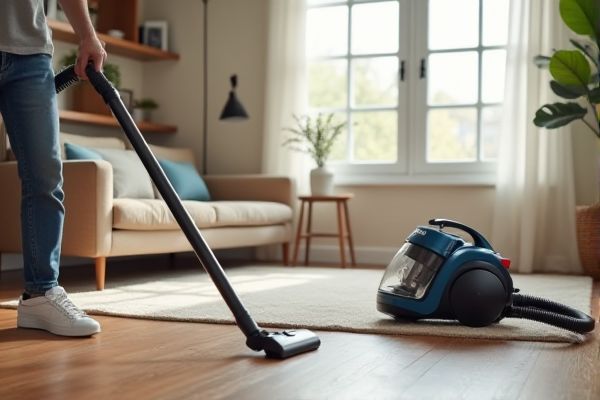
Built-in vacuums offer powerful suction and seamless integration for whole-home cleaning, while portable vacuums provide convenient mobility and easy access to tight spaces. Discover which vacuum type best suits Your cleaning needs in the rest of this article.
Table of Comparison
| Feature | Built-in Vacuum | Portable Vacuum |
|---|---|---|
| Installation | Requires professional installation, integrated into walls or floors | No installation needed, ready to use out of the box |
| Mobility | Fixed location, limited to hose reach | Highly portable, lightweight, easy to carry |
| Power Source | Typically hardwired to home electrical system | Battery-powered or corded options available |
| Suction Power | Strong, consistent suction with powerful motors | Varies, generally less powerful than built-in models |
| Storage | Centralized unit, hides dust and motor components | Needs separate storage space, often bulky |
| Maintenance | Less frequent dust emptying; professional servicing | Frequent dustbin emptying and filter cleaning |
| Noise Level | Quieter operation, motor isolated | Louder due to motor proximity |
| Price Range | Higher upfront cost, long-term investment | Affordable, variable pricing based on brand and features |
| Ideal Use | Whole-house cleaning, permanent solution | Small spaces, quick cleanups, spot cleaning |
Introduction to Built-In and Portable Vacuums
Built-in vacuum systems offer powerful suction with concealed installation, enhancing home aesthetics and convenience by eliminating the need to carry equipment between rooms. Portable vacuums provide flexibility and ease of use for quick cleanups and spot cleaning, making them ideal for smaller spaces or vehicles. You can choose the right option based on your cleaning needs, home size, and storage preferences.
Main Features of Built-In Vacuum Systems
Built-in vacuum systems offer powerful suction with centralized motors typically installed in a utility area, reducing noise and improving air quality throughout your home. These systems include strategically placed inlets connected by concealed tubing, allowing for easy and efficient cleaning without lugging a portable unit around. You benefit from enhanced convenience and increased property value with a permanent, low-maintenance solution tailored to your home's layout.
Core Advantages of Portable Vacuum Cleaners
Portable vacuum cleaners offer unmatched flexibility and convenience, allowing you to easily clean multiple spaces without being tethered to a fixed location. Their lightweight design and cordless operation enable swift maneuverability, making them ideal for quick cleanups and hard-to-reach areas. Unlike built-in vacuum systems, portable vacuums require minimal installation and provide immediate access to powerful suction wherever you need it.
Installation Process: Built-In vs Portable
Built-in vacuum systems require professional installation involving in-wall tubing, inlet valves, and a centralized power unit, which can take several hours to days depending on the home size. Portable vacuums offer immediate use without installation, simply needing to be charged or plugged in, making them ideal for quick cleaning or small spaces. The upfront complexity and cost of built-in vacuums contrast with the convenience and flexibility provided by portable vacuum cleaners.
Cleaning Efficiency Comparison
Built-in vacuums deliver superior cleaning efficiency through consistent suction power and integrated systems that target dust and allergens deep within carpets and floors. Portable vacuums offer versatility and convenience for quick cleanups and hard-to-reach areas but often have less suction strength and smaller dust capacity. Choosing between the two depends on the cleaning scope, with built-in systems excelling in thorough whole-home cleaning and portable units providing efficient spot cleaning.
Maintenance Requirements and Costs
Built-in vacuums generally require less frequent maintenance due to their powerful motors and centralized debris collection systems, resulting in lower long-term costs despite higher initial installation fees. Portable vacuums demand more frequent filter changes, battery replacements, and part cleanings, increasing maintenance efforts and expenses over time. Selecting a vacuum depends on balancing upfront investment with ongoing upkeep and repair costs tailored to specific cleaning needs.
Space and Storage Considerations
Built-in vacuum systems save valuable floor space by eliminating the need for bulky equipment storage, as all components are integrated into walls or closets. Portable vacuums require dedicated storage areas, often occupying closets or utility rooms, which can be challenging in smaller living spaces. Considering your available space and storage options will help determine whether a built-in or portable vacuum system best fits your home's layout.
Noise Levels: Built-In vs Portable Options
Built-in vacuum systems typically produce lower noise levels compared to portable vacuums because their motor is installed remotely, often in a basement or garage, significantly reducing in-room sound. Portable vacuums generate more noise at the point of use since their motor operates directly within the cleaning unit, leading to higher immediate sound exposure. Homeowners seeking quieter cleaning solutions often prefer built-in systems for their ability to minimize noise disturbances.
Long-Term Value and Durability
Built-in vacuums offer superior long-term value and durability due to their robust construction and integration into your home's infrastructure, reducing the need for frequent replacements. Portable vacuums, while convenient and lightweight, typically have shorter lifespans and may require more maintenance or battery replacements over time. Investing in a built-in system ensures consistent performance and longevity, making it a cost-effective option for homeowners prioritizing durability.
Which Vacuum Solution Suits Your Home?
Built-in vacuum systems are ideal for larger homes, offering powerful suction, quiet operation, and convenient disposal of dust through centralized units typically installed in basements or utility rooms. Portable vacuums provide flexibility for smaller spaces or quick clean-ups, featuring lightweight designs and cordless options for easy maneuverability and storage. Choosing between built-in and portable vacuums depends on your home's size, layout, and cleaning needs, with built-in systems excelling in efficiency and portability offering versatility.
 homyna.com
homyna.com